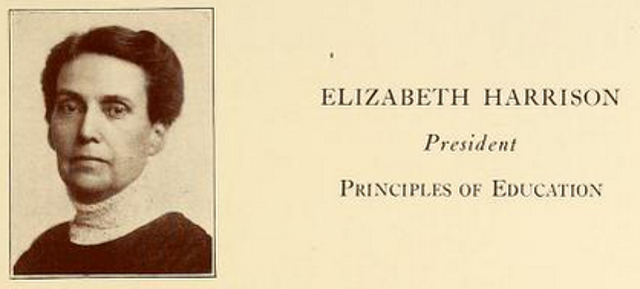
Elizabeth Harrison’s Writings
Files
Download Full Text (10.6 MB)
Description
From the introduction of The Kindergarten Building Gifts:
To refuse to pass judgment upon a subject not yet understood is one of the surest evidences of the cultured mind. It is, therefore, with a feeling of confidence that the kindergartners ask the rest of the educational world to first understand Froebel's aim in creating the kindergarten Play-Gifts and see whether or not they fulfill the purpose in which they were made.
No one can easily comprehend Froebel without understanding his idea of the meaning of life. Over and over again he has stated that the chief end of education should be to bring the human soul to a consciousness of his oneness with the Divine Source of all things. This feeling of oneness with God was to him the greatest possible inspiration that could be given to a child to awaken it to a faith in itself.
All modern Sociology is beginning to demand as the true ethical basis of the institutional life believed would follow when the world understood the brotherhood of man. All that modern education is beginning to demand concerning the development of the individuality of each child, he believed would then be readily conceded.
His kindergarten games were devised for no other purpose than to bring the to child, through joyous, child-like, dramatic play, to the fundamental relationships of family life, of society, of the trade world, and to a more limited extent, to a dawning of consciousness of the meaning of the state and church. It is true that they are played in time to music and that the words are usually sung, thereby exercising the child in rhythmic and healthful movement, and giving the needed physical activity and diversion of mind, but these things were a means to an end.
It is equally true that his so-called gifts and occupations (the play-tools which he puts into the hands of the kindergartner), were not created by him merely that the child might the sooner master the material world about him by becoming familiar with the fundamental properties of the matter through play with them: as, for example, to gain lasting sense-impressions by means of sharp contrast of large and small forms, curved and flat surfaces, long and short lines, near and far points, fixed and transformable shapes, bright and soft colors, rough and smooth textures, etc. etc.; nor was it his purpose simply to give the child objects by means of which he might the more readily classify the myriads of sensations that pour in upon his young mind. It is true that the few forms which are seen in the Kindergarten Gifts are the geometric types that underlie all forms of creation, and are therefore most helpful in the rational organization of what to the child is the chaos of the outside world, but to Frobel this was a means to an end. This end was to lead the young heart, through thus discerning the organized nature of form, to feel that underneath all forms lay one form, that one law governed by all creation, that all were but varying expressions or utterances of One Mind.
The above is a short and inadequate statement of the world-view of one of the most truly religious minds of modern times.
-Elizabeth Harrison
Publication Date
1903
Publisher
Sigma Publishing Co.
City
Chicago; St. Louis
Keywords
Froebel Gifts, Froebel, Kindergarten Gifts, Kindergarten
Disciplines
Education | Pre-Elementary, Early Childhood, Kindergarten Teacher Education | Teacher Education and Professional Development
Recommended Citation
Harrison, Elizabeth and Woodsen, Belle, "The Kindergarten Building Gifts" (1903). Elizabeth Harrison’s Writings. 12.
https://digitalcommons.nl.edu/harrison-writings/12



Comments
This book has been made digitally available by support from the Consortium of Academic and Research Libraries in Illinois and the Internet Archive.